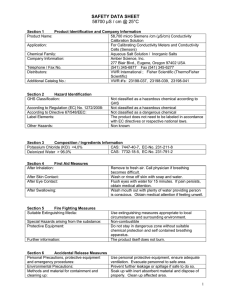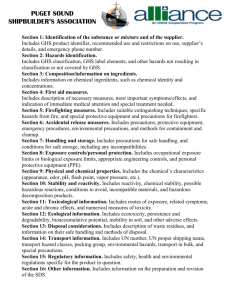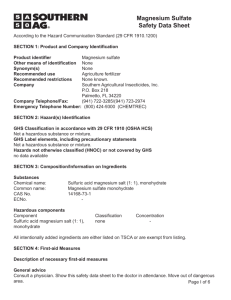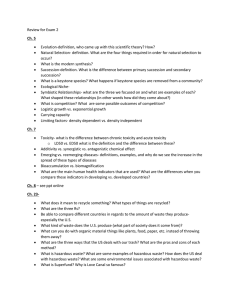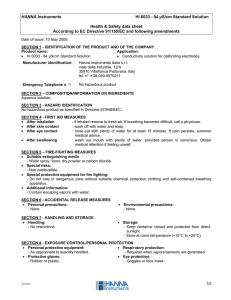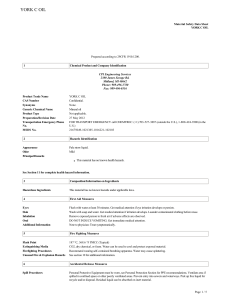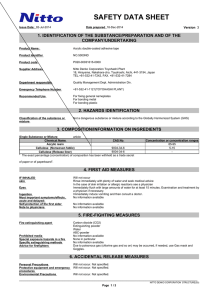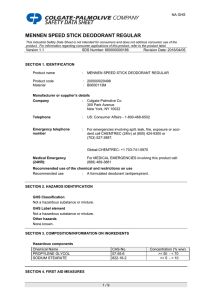718 µS SDS - Amber Science - Conductivity Instrument Manufacturers
advertisement
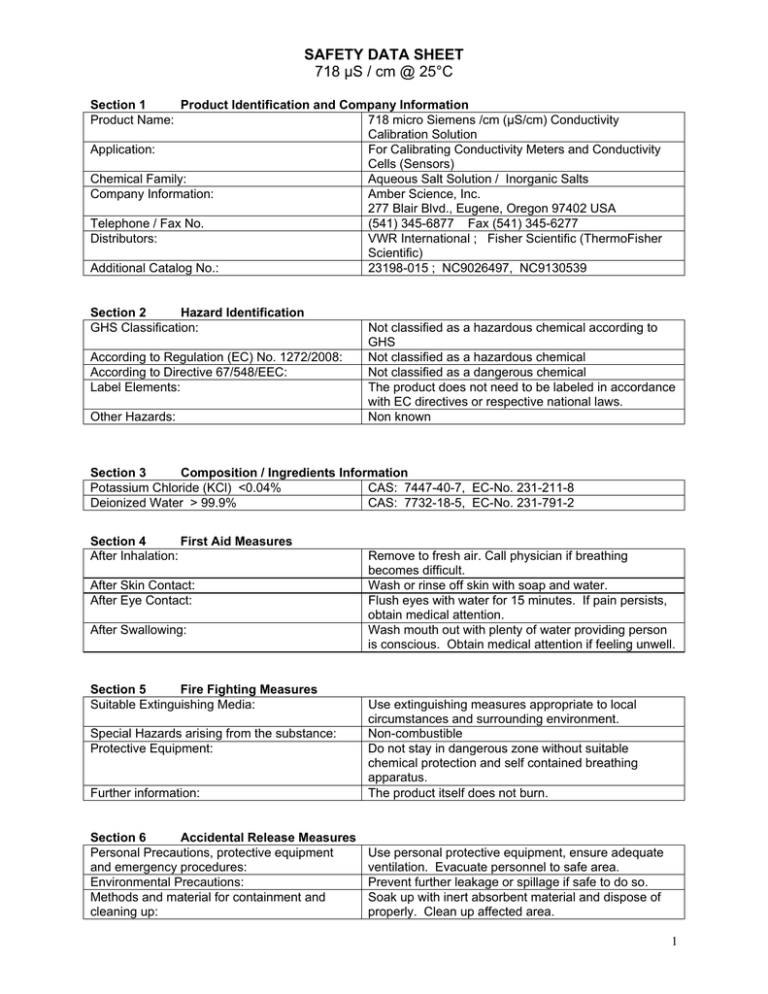
SAFETY DATA SHEET 718 µS / cm @ 25°C Section 1 Product Identification and Company Information Product Name: 718 micro Siemens /cm (µS/cm) Conductivity Calibration Solution Application: For Calibrating Conductivity Meters and Conductivity Cells (Sensors) Chemical Family: Aqueous Salt Solution / Inorganic Salts Company Information: Amber Science, Inc. 277 Blair Blvd., Eugene, Oregon 97402 USA Telephone / Fax No. (541) 345-6877 Fax (541) 345-6277 Distributors: VWR International ; Fisher Scientific (ThermoFisher Scientific) Additional Catalog No.: 23198-015 ; NC9026497, NC9130539 Section 2 Hazard Identification GHS Classification: According to Regulation (EC) No. 1272/2008: According to Directive 67/548/EEC: Label Elements: Other Hazards: Not classified as a hazardous chemical according to GHS Not classified as a hazardous chemical Not classified as a dangerous chemical The product does not need to be labeled in accordance with EC directives or respective national laws. Non known Section 3 Composition / Ingredients Information Potassium Chloride (KCl) <0.04% CAS: 7447-40-7, EC-No. 231-211-8 Deionized Water > 99.9% CAS: 7732-18-5, EC-No. 231-791-2 Section 4 First Aid Measures After Inhalation: After Skin Contact: After Eye Contact: After Swallowing: Section 5 Fire Fighting Measures Suitable Extinguishing Media: Remove to fresh air. Call physician if breathing becomes difficult. Wash or rinse off skin with soap and water. Flush eyes with water for 15 minutes. If pain persists, obtain medical attention. Wash mouth out with plenty of water providing person is conscious. Obtain medical attention if feeling unwell. Further information: Use extinguishing measures appropriate to local circumstances and surrounding environment. Non-combustible Do not stay in dangerous zone without suitable chemical protection and self contained breathing apparatus. The product itself does not burn. Section 6 Accidental Release Measures Personal Precautions, protective equipment and emergency procedures: Environmental Precautions: Methods and material for containment and cleaning up: Use personal protective equipment, ensure adequate ventilation. Evacuate personnel to safe area. Prevent further leakage or spillage if safe to do so. Soak up with inert absorbent material and dispose of properly. Clean up affected area. Special Hazards arising from the substance: Protective Equipment: 1 SAFETY DATA SHEET 718 µS / cm @ 25°C Continued Section 7 Handling and Storage Precautions for safe handling: Conditions for safe storage: Avoid contact with skin and eyes. Keep container tightly closed and store at room temperature (15°C to 25°C). Avoid exposure to sunlight. Section 8 Exposure Controls / Personal Protection Eye / Face Protection: Approved Safety glasses with side shields. Skin Protection: Gloves may be used to avoid skin contact. Body Protection: Normal room ventilation is adequate. Appropriate clothing and or Lab Coat may be worn. Appropriate Engineering Controls: Handle in accordance with good industrial hygiene. Section 9 Physical and Chemical Properties Appearance: Colorless Liquid Odor: Odorless pH Value: Approximately 7 pH Boiling Point (Degree C): Approximately 100°C Melting Point: Not Applicable Flash Point: Not Applicable Water Solubility: Soluble Explosion Limits: Not Applicable Specific Gravity: 1.0 g/cm³ Other Information: No further relevant information available Section 10 Stability and Reactivity Reactivity: Chemical Stability: Possibility of Hazardous Reactions: Conditions to Avoid: Incompatible Materials: Hazardous Decomposition products: Section 11 Toxicological Information Product Toxicity: Inhalation: Skin Contact: Eye Contact: Ingestion: Specific target organ toxicity – single exposure: Specific target organ toxicity – repeated exposure: Section 12 Ecological Information Toxicity: Persistence and degradability: Bio accumulative potential: No data available Stable under standard ambient conditions Not to be expected due to low concentration of dissolved substances. Heating Strong Acids, strong oxidizing agents No data available No data available May cause respiratory tract irritation. May cause skin irritations. May cause eye irritations. Harmful if swallowed. No data available No data available No data available No data available No data available 2 SAFETY DATA SHEET 718 µS / cm @ 25°C Continued Section 12 Ecological Information Results of PBT and vPvB assessment: Other Adverse Effects: Additional Ecological Information: Section 13 Disposal Consideration Waste Disposal: No data available No further relevant information available. No ecological problems are to be expected when the product is handled and used with due care. Recommended Cleaning Agent: Liquid may be flushed into the sewer. Dispose of in accordance with local, state and federal regulations. Water. Section 14 Transport Information Land, Sea, Air, Rail: Un-Number: Environmental Hazards – Marine Pollutant: Not subject to transport regulations Not regulated No Section 15 Regulatory Information Complies with Requirements: Section 16 Other Information SDS Revision Date: Prior Revision Date: OSHA Regulation 29 CFR 1910.1200 European Regulations (EC) No. 1272/2008 Canadian Regulation SOR/88-66 June 01, 2015 April 30, 2008 The above information is believed to be accurate but does not purport to be all inclusive and shall be used only as a guide. The information contained in this document is based on our knowledge and is applicable only to the product with regard to appropriate safety precautions. This does not represent any guarantee of the properties of the product. Company will not be held liable for any damage resulting from the use or contact with the above product. 3
